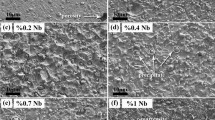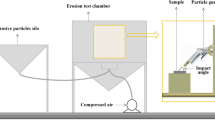Abstract
Stainless steels are widely used in a variety of engineering applications such as food appliances, surgical instruments, nuclear reactors and cryogenic applications. The properties of stainless steel are greatly affected by the grain size. The present study investigates the effect of grain size on sliding wear behavior of AISI 304 stainless steel. The sliding wear properties are measured using a Pin-on-Disc machine. Annealing heat treatment process varies the grain size of steel at 1100 °C. The wear test is performed on different grain sizes of AISI 304 steel at various sliding speeds under dry condition. The wear rate of the steels at different sliding distances is plotted as a function of grain size. The maximum wear rate is obtained at an intermediate grain size. It is noted that frictional force and temperature initially increases and then reaches the saturation plateau. The results are used to establish a correlation between the grain size and sliding wear properties of stainless steel. The present study is useful in enhancing the life of various components made of the stainless steel.













Similar content being viewed by others
Abbreviations
- ASTM:
-
American society for testing and materials
- UTS:
-
Ultimate tensile strength
- YS:
-
Yield strength
- σ0 :
-
Frictional stress opposing dislocation moment
- τ*:
-
Effective shear stress
- k:
-
Dislocation-locking constant
- \(\tau_{a}\) :
-
Applied resolved shear stress
- \(\tau_{0}\) :
-
Frictional stress
- \(\tau_{C}\) :
-
Obstacle shear stress or the stress necessary to nucleate slip in the adjacent grain
- m*:
-
Average orientation factor
- G:
-
Shear modulus
- b:
-
Burgers vectors
- A:
-
Constant related to dislocation character
- m:
-
Orientation factor for converting normal stress to shear stress
- X:
-
Average distance of dislocation slip
- D:
-
Grain size
- α, β:
-
Coefficients
- Do :
-
Size at zero time
- K:
-
Slope
- t:
-
Soaking time
References
Bezzazi M, Khamlichi A, Jabbouri A, Reis P, and Davim J P, Mater Des 28 (2007) 2148.
Chaudhari R, Ingle A, and Kalita K, Mater Focus 5 (2016) 440.
Czichos H, ASLE Tran 17 (1974) 300.
Eshelby J, Frank F, and Nabarro F, London Edinburgh Dublin Philos Mag J Sci 42 (1951) 351.
Hall E, Proc Phys Soc Sect B 64 (1951) 747.
Irvine K, Gladman T, and Pickering F, J Iron Steel Inst 207 (1969) 1017.
Liu W H, Wu Y, He J Y, Nieh T G, and Lu Z P, Scripta Mater 68 (2013) 526.
Mindlin R, Exp Mech 3 (1963) 1.
Nyman P, Mäki R, Olsson R, and Ganemi B, Wear 261 (2006) 46.
Peierls R, Proc Phys Soc 52 (1940) 34.
Petch N, J Iron Steel Inst 174 (1953) 25.
Pickering F, Int Met Rev 21 (1976) 227.
Zou Q, Rao C, Barber G, Zhou B, and Wang Y, Wear 302 (2013) 1378.
Author information
Authors and Affiliations
Corresponding author
Rights and permissions
About this article
Cite this article
Chaudhari, R., Ingle, A. & Kalita, K. Tribological Investigation of Effect of Grain Size in 304 Austenitic Stainless Steel. Trans Indian Inst Met 70, 2399–2405 (2017). https://doi.org/10.1007/s12666-017-1101-2
Received:
Accepted:
Published:
Issue Date:
DOI: https://doi.org/10.1007/s12666-017-1101-2




